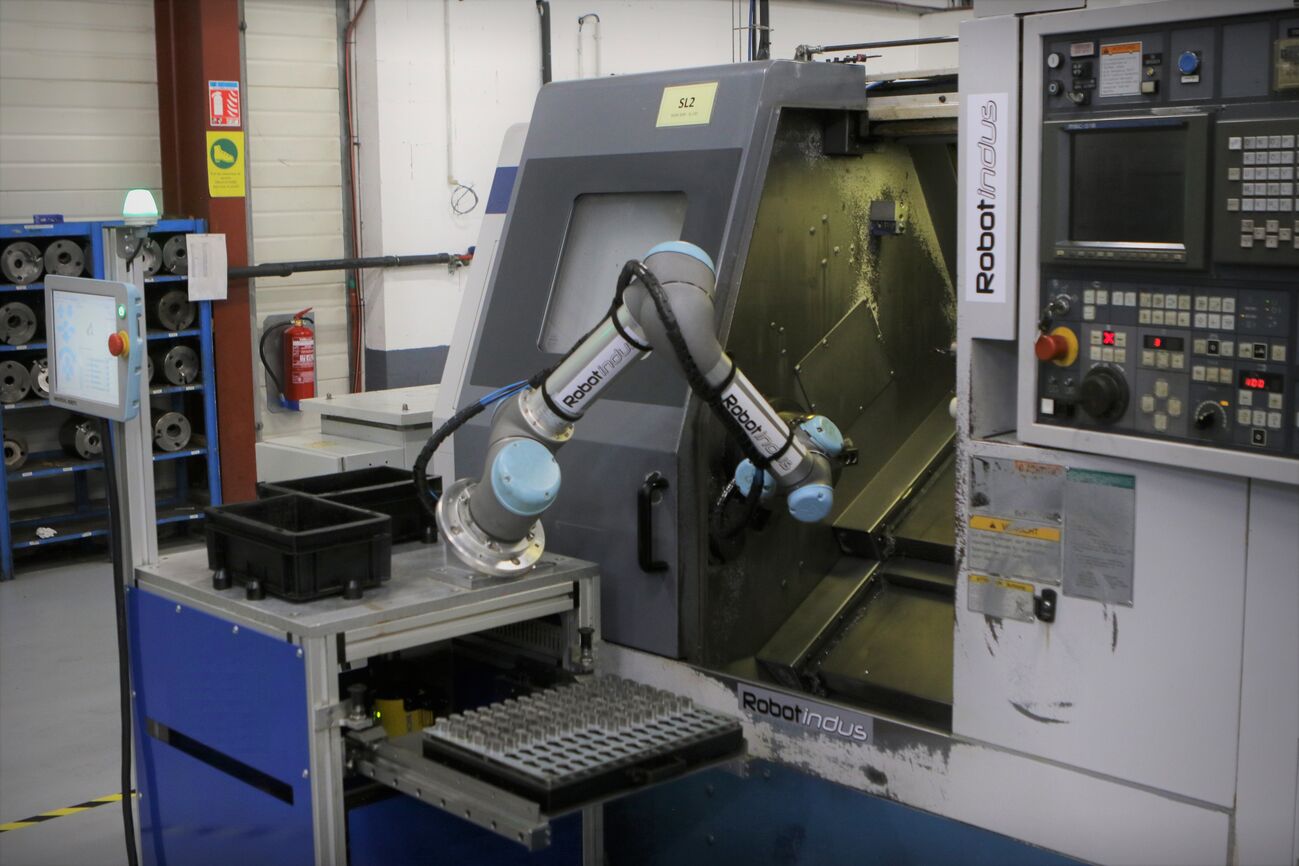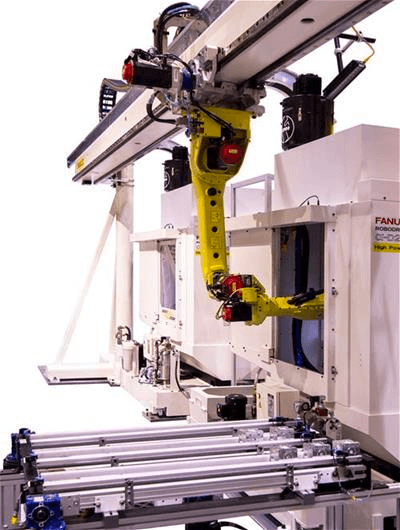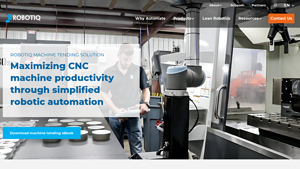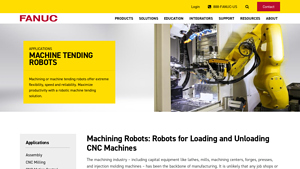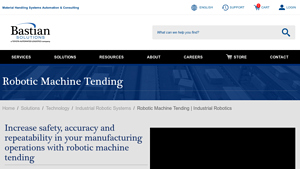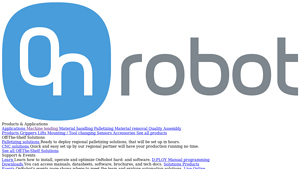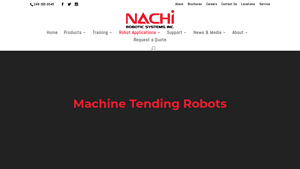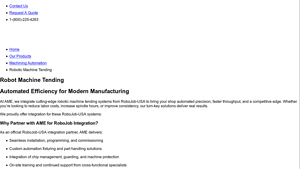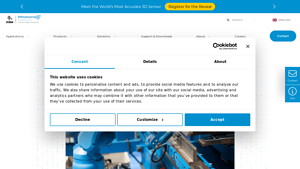Machine Tending Robot Guide: Type, Cost, Top List…
Introduction: Navigating the Global Market for machine tending robot
In today’s competitive landscape, sourcing the right machine tending robot can significantly enhance operational efficiency and address the pressing challenge of skilled labor shortages. As manufacturers strive to optimize productivity, automated machine tending solutions offer a pathway to streamline processes, reduce downtime, and minimize human error. This comprehensive guide delves into the multifaceted world of machine tending robots, exploring various types, their diverse applications, and effective strategies for supplier vetting and cost management.
International B2B buyers, particularly those from regions such as Africa, South America, the Middle East, and Europe, will find actionable insights tailored to their unique market dynamics. The guide aims to empower decision-makers by providing essential information on the latest technologies and trends in robotic automation, enabling them to make informed purchasing decisions that align with their business objectives.
By examining case studies and real-world applications, readers will gain a deeper understanding of how machine tending robots can transform manufacturing operations, from CNC machines to injection molding setups. Equip yourself with the knowledge to navigate the global market for machine tending robots, ensuring that your business remains competitive and responsive to the evolving demands of the industry.
Understanding machine tending robot Types and Variations
| Type Name | Key Distinguishing Features | Primary B2B Applications | Brief Pros & Cons for Buyers |
|---|---|---|---|
| Collaborative Robots (Cobots) | Designed to work alongside human operators; adaptable and easy to program. | CNC machine tending, assembly lines, packaging. | Pros: Enhanced worker safety, easy integration. Cons: Limited payload compared to industrial robots. |
| Industrial Robots | High payload capacity and speed; typically require safety cages. | Heavy manufacturing, automotive assembly, welding. | Pros: High efficiency for large-scale operations. Cons: Higher upfront costs and complex programming. |
| Automated Guided Vehicles (AGVs) | Mobile robots that transport materials autonomously within a facility. | Warehousing, logistics, and material handling. | Pros: Reduces labor costs, improves material flow. Cons: Requires infrastructure investment for navigation. |
| Delta Robots | High-speed, parallel robots ideal for picking and packing tasks. | Food processing, electronics assembly, pharmaceuticals. | Pros: Exceptional speed and precision. Cons: Limited range of motion; best for specific tasks. |
| Vision-Guided Robots | Equipped with cameras and sensors for precise operation and quality control. | Inspection, sorting, and complex assembly tasks. | Pros: Enhanced accuracy and adaptability. Cons: Higher complexity and cost due to additional components. |
What Are Collaborative Robots and Their Suitability for B2B Buyers?
Collaborative robots, or cobots, are designed for close interaction with human workers. Their ease of programming and adaptability make them suitable for various applications, such as CNC machine tending and assembly lines. For B2B buyers, these robots offer enhanced safety and flexibility, allowing businesses to integrate them into existing workflows without significant modifications. However, cobots typically have a lower payload capacity than traditional industrial robots, which may limit their use in heavy-duty tasks.
How Do Industrial Robots Compare for High-Payload Applications?
Industrial robots are characterized by their high payload capacity and operational speed, making them ideal for heavy manufacturing environments, such as automotive assembly and welding. These robots often require safety cages due to their powerful movements. B2B buyers should consider the initial investment and complexity of programming when opting for industrial robots, as they can deliver significant efficiency gains for large-scale operations, ultimately resulting in faster ROI.
What Role Do Automated Guided Vehicles Play in Material Handling?
Automated Guided Vehicles (AGVs) are mobile robots that autonomously transport materials within a facility. They are increasingly used in warehousing and logistics to streamline material flow and reduce labor costs. For businesses looking to enhance operational efficiency, AGVs represent a valuable investment. However, buyers should be aware that implementing AGVs requires infrastructure modifications for navigation and tracking, which can lead to additional costs.
In What Scenarios Are Delta Robots Most Effective?
Delta robots are known for their exceptional speed and precision, making them ideal for applications such as picking, packing, and sorting in industries like food processing and electronics assembly. B2B buyers will find delta robots particularly advantageous when high-speed operations are critical. Nonetheless, their limited range of motion means they are best suited for specific tasks rather than versatile operations.
Why Consider Vision-Guided Robots for Complex Assembly Tasks?
Vision-guided robots are equipped with cameras and sensors, enabling them to perform precise operations such as inspection and sorting. This technology is particularly beneficial for complex assembly tasks that require high accuracy. For B2B buyers, the enhanced adaptability of vision-guided robots can lead to improved product quality and reduced error rates. However, the additional components and complexity associated with these systems may result in higher costs, which should be factored into purchasing decisions.
Key Industrial Applications of machine tending robot
| Industry/Sector | Specific Application of machine tending robot | Value/Benefit for the Business | Key Sourcing Considerations for this Application |
|---|---|---|---|
| Automotive Manufacturing | Loading/unloading CNC machines for part production | Increased throughput and reduced labor costs | Compatibility with existing CNC machines, ease of integration |
| Aerospace | Precision part handling for machining operations | Enhanced accuracy and reduced scrap rates | High payload capacity, safety features, and programming flexibility |
| Metal Fabrication | Automated handling of metal parts in welding stations | Improved safety and reduced manual handling risks | Robust design for harsh environments, customizable end-effectors |
| Consumer Electronics | Assembly line support for component placement | Streamlined production and higher quality assurance | Adaptability to various part sizes, ease of programming |
| Medical Devices | Loading and unloading precision instruments | Increased operational efficiency and compliance with safety standards | Precision gripping tools, compliance with regulatory standards |
How Are Machine Tending Robots Used in Automotive Manufacturing?
In the automotive sector, machine tending robots are primarily utilized for loading and unloading parts from CNC machines. This automation addresses the challenge of skilled labor shortages and increases production capacity. By ensuring consistent and accurate part handling, these robots minimize the risk of machine jams and errors, which can lead to costly downtime. International buyers should consider the compatibility of these robots with existing CNC systems, as well as their ability to integrate seamlessly into current workflows.
What Role Do Machine Tending Robots Play in Aerospace Applications?
In aerospace manufacturing, machine tending robots handle high-precision components during machining operations. These robots provide the necessary accuracy to meet stringent industry standards while significantly reducing scrap rates. By automating the loading and unloading processes, manufacturers can enhance productivity and ensure that skilled operators focus on value-added tasks. For buyers in this sector, it’s essential to evaluate the robot’s payload capacity and safety features, as well as its adaptability to various machining environments.
How Do Machine Tending Robots Enhance Metal Fabrication Processes?
In metal fabrication, machine tending robots automate the handling of metal parts in welding stations and other processes. This automation not only improves productivity but also enhances workplace safety by reducing manual handling risks. By maintaining consistent quality in part handling, these robots help manufacturers minimize defects. Buyers should look for robust designs that can withstand harsh environments and customizable end-effectors that cater to specific part shapes and sizes.
What Are the Benefits of Machine Tending Robots in Consumer Electronics Manufacturing?
In the consumer electronics industry, machine tending robots support assembly lines by accurately placing components. This automation leads to streamlined production processes and higher quality assurance, reducing the likelihood of defects. As manufacturers strive for just-in-time production, these robots can adapt to various part sizes and specifications. For international buyers, ease of programming and adaptability to different assembly tasks are critical considerations when sourcing these solutions.
How Are Machine Tending Robots Transforming Medical Device Production?
Machine tending robots are increasingly vital in the production of medical devices, where precision and compliance with safety standards are paramount. These robots automate the loading and unloading of precision instruments, enhancing operational efficiency and ensuring high standards of quality control. Buyers in this sector must prioritize sourcing robots equipped with precision gripping tools and those that comply with stringent regulatory standards to ensure product safety and reliability.
3 Common User Pain Points for ‘machine tending robot’ & Their Solutions
Scenario 1: Overcoming Skilled Labor Shortages in Manufacturing
The Problem: Many manufacturing companies, particularly in regions like Africa and South America, are facing a critical shortage of skilled labor. This shortage hampers productivity, as CNC machines often operate at only 60-70% capacity due to the inability to find operators who can perform the required tasks efficiently. The repetitive nature of machine tending roles can lead to high turnover rates and a general disinterest among potential workers. As a result, companies miss out on potential revenue and struggle to meet customer demands, leading to financial strain and diminished market competitiveness.
The Solution: To address this labor challenge, businesses should invest in collaborative robots (cobots) designed for machine tending. These robots can easily be programmed and integrated into existing workflows, providing a seamless transition from human labor to automation. When sourcing these robots, buyers should look for models that allow for quick reprogramming and adaptability to various tasks, ensuring that the initial investment is not only cost-effective but also flexible enough to meet changing production needs. For instance, solutions like Universal Robots’ UR series offer user-friendly interfaces that enable operators with minimal technical expertise to manage and adjust the robots. By automating mundane tasks, companies can free up skilled workers to focus on higher-value activities, thus improving overall productivity and employee satisfaction.
Scenario 2: Reducing Production Downtime Due to Machine Jams
The Problem: Machine jams and misalignments during material loading can result in significant production downtime, leading to increased costs and potential loss of revenue. This is particularly problematic for manufacturers in the Middle East and Europe, where operational efficiency is crucial for maintaining competitiveness. These incidents not only delay production schedules but can also lead to equipment damage, which further exacerbates downtime and increases repair costs.
The Solution: Implementing a robust machine tending robot system can effectively minimize these risks. Buyers should prioritize solutions that include advanced sensing technologies, such as vision systems and spatial awareness sensors, which can detect misalignments before they lead to jams. For example, integrating a cobot with a comprehensive quality control system will allow for real-time monitoring of the loading process, ensuring that materials are handled correctly and efficiently. Additionally, selecting a robot with customizable end-of-arm tools can enhance precision and adaptability, allowing for adjustments based on the specific dimensions and weights of materials being processed. Manufacturers should also consider investing in training programs for staff to ensure they can quickly troubleshoot and resolve any issues that arise during production, further reducing downtime.
Scenario 3: Ensuring Consistency and Quality in Production
The Problem: Maintaining consistent quality across production runs is a common challenge faced by manufacturers, especially in regions with varying quality standards and practices. Inconsistent material handling can lead to defective products, increased scrap rates, and a tarnished reputation in the market. This issue is often exacerbated when human operators are fatigued or distracted, which can lead to errors in loading and unloading materials from CNC machines.
The Solution: To combat these quality control issues, businesses should implement automated machine tending solutions that guarantee consistency in material handling. Robotic solutions, such as those offered by Robotiq, allow for the automation of repetitive loading and unloading tasks, ensuring that every part is handled in the same manner. When selecting a machine tending robot, companies should look for systems that provide easy programming capabilities and quick setup to minimize the learning curve for operators. Incorporating a feedback loop into the production process can also be beneficial; for example, using data analytics to monitor production quality can help identify trends and areas for improvement. By investing in robust machine tending technology, manufacturers can not only enhance product quality but also build a reputation for reliability and excellence in their respective markets.
Strategic Material Selection Guide for machine tending robot
What Are the Key Materials Used in Machine Tending Robots?
When selecting materials for machine tending robots, several factors come into play, including performance, durability, cost, and compliance with international standards. Here, we analyze four common materials used in the construction of machine tending robots: aluminum, stainless steel, plastic composites, and carbon fiber.
How Does Aluminum Benefit Machine Tending Robots?
Aluminum is widely used in the construction of machine tending robots due to its lightweight and high strength-to-weight ratio. Key properties include excellent corrosion resistance and good thermal conductivity, making it suitable for environments with varying temperatures.
Pros: Aluminum is relatively inexpensive, easy to machine, and can be anodized to enhance its corrosion resistance. Its lightweight nature allows for faster movements, improving the overall efficiency of the robot.
Cons: While aluminum is durable, it can be less robust than other metals like steel, especially under high-stress conditions. Additionally, it may not withstand extreme temperatures as effectively as some alternatives.
Impact on Application: Aluminum’s compatibility with various media makes it ideal for a range of applications, from CNC machining to injection molding. However, care must be taken in environments with high heat or abrasive materials.
Considerations for International Buyers: Buyers from regions like Africa and South America should ensure compliance with local standards such as ASTM for material quality. The lightweight nature of aluminum is particularly beneficial in regions with high shipping costs.
Why Choose Stainless Steel for Machine Tending Robots?
Stainless steel is another popular material, known for its exceptional strength and corrosion resistance. It can withstand harsh environments, making it ideal for applications where exposure to moisture or chemicals is a concern.
Pros: Its durability ensures a longer lifespan, reducing maintenance costs. Stainless steel is also non-reactive, making it suitable for food processing and pharmaceutical applications.
Cons: The primary drawback is its higher cost compared to aluminum. Additionally, stainless steel is heavier, which may affect the speed and agility of the robot.
Impact on Application: Stainless steel is particularly effective in environments where hygiene is critical, such as food and beverage manufacturing. Its robustness allows it to handle heavy loads without compromising performance.
Considerations for International Buyers: Compliance with standards like DIN and JIS is essential, especially in Europe and the Middle East. Buyers should also consider the availability of stainless steel components in their local markets.
What Role Do Plastic Composites Play in Machine Tending Robots?
Plastic composites are increasingly being used in machine tending robots due to their versatility and lightweight properties. They offer good chemical resistance and can be molded into complex shapes.
Pros: The manufacturing process for plastic composites can be less expensive and more straightforward than metals. They are also resistant to corrosion and can be tailored for specific applications.
Cons: While they are lightweight, plastic composites may not have the same load-bearing capacity as metals. They can also be more susceptible to wear and tear, especially in high-friction applications.
Impact on Application: These materials are ideal for non-load-bearing components and can be used in environments where chemical exposure is a concern. However, their limitations in strength may restrict their use in heavy-duty applications.
Considerations for International Buyers: Buyers should ensure that plastic composites meet relevant standards, particularly in industries like automotive and aerospace, where compliance is critical.
How Does Carbon Fiber Enhance Machine Tending Robots?
Carbon fiber is known for its high strength-to-weight ratio and rigidity, making it a premium choice for high-performance applications. Its properties include excellent tensile strength and low thermal expansion.
Pros: Carbon fiber components can significantly reduce the weight of the robot, improving speed and efficiency. They also offer high resistance to fatigue and corrosion.
Cons: The primary disadvantage is the high cost of carbon fiber materials and the complexity of manufacturing processes involved. This can make them less accessible for small to medium-sized enterprises.
Impact on Application: Carbon fiber is particularly beneficial in applications requiring high precision and speed, such as aerospace or high-end automotive manufacturing. Its lightweight nature allows for rapid movements, enhancing productivity.
Considerations for International Buyers: Buyers should be aware of the higher costs associated with carbon fiber and ensure compliance with international standards, especially in high-tech industries.
Summary Table of Material Selection for Machine Tending Robots
| Material | Typical Use Case for Machine Tending Robot | Key Advantage | Key Disadvantage/Limitation | Relative Cost (Low/Med/High) |
|---|---|---|---|---|
| Aluminum | General machine tending applications | Lightweight and cost-effective | Less durable under high stress | Low |
| Stainless Steel | Food processing, heavy-duty applications | Exceptional strength and durability | Higher cost and heavier weight | High |
| Plastic Composites | Non-load-bearing components | Cost-effective and versatile | Lower load-bearing capacity | Medium |
| Carbon Fiber | High-performance applications | High strength-to-weight ratio | High cost and complex manufacturing | High |
This strategic material selection guide provides insights into the advantages and limitations of various materials used in machine tending robots, enabling international B2B buyers to make informed decisions based on their specific operational needs and regional compliance requirements.
In-depth Look: Manufacturing Processes and Quality Assurance for machine tending robot
What Are the Main Stages in the Manufacturing Process of Machine Tending Robots?
The manufacturing process for machine tending robots typically involves several key stages: material preparation, forming, assembly, and finishing. Understanding these stages is crucial for B2B buyers, as they provide insights into the quality and reliability of the robots being procured.
Material Preparation
The first step involves selecting high-quality materials that meet the specifications required for durability and performance. Common materials include aluminum alloys for lightweight structures, high-strength plastics for housings, and steel for critical components. Suppliers often conduct thorough inspections of raw materials to ensure compliance with international standards, such as ISO 9001, which emphasizes quality management systems.
Forming Techniques
Forming techniques vary based on the design requirements of the robot. Common methods include CNC machining, laser cutting, and injection molding. CNC machining is widely used for precision components, ensuring that parts meet exact tolerances, which is vital for the performance of the robot. Injection molding is often employed for creating complex shapes in plastic components, allowing for efficient mass production while maintaining quality.
Assembly Process
During the assembly stage, various components are integrated to create the final machine tending robot. This process often utilizes automated assembly lines to enhance efficiency and accuracy. Key components such as the robot arm, end-of-arm tooling (EOAT), sensors, and controllers are assembled meticulously. Quality control checkpoints are established to verify that each assembly step meets predetermined specifications. For B2B buyers, understanding the assembly process can help gauge the sophistication and reliability of the manufacturing operation.
Finishing Techniques
Finishing techniques, including painting, coating, and surface treatment, are applied to enhance durability and aesthetics. These processes protect the robot from environmental factors and wear, extending its operational lifespan. Buyers should inquire about the finishing techniques used by suppliers to ensure that the robots can withstand the conditions in their specific operational environments.
How Is Quality Assurance Implemented in Machine Tending Robot Manufacturing?
Quality assurance is a critical aspect of manufacturing machine tending robots. It ensures that the final product meets the required standards and performs reliably in various applications. The following outlines the key quality control measures typically implemented in this industry.
What International Standards Are Relevant for Machine Tending Robots?
International standards play a vital role in ensuring the quality and safety of machine tending robots. ISO 9001 is the most recognized quality management standard, focusing on continuous improvement and customer satisfaction. Compliance with this standard indicates that a manufacturer has established a quality management system that meets global best practices.
In addition to ISO 9001, machine tending robots may need to adhere to industry-specific standards such as CE marking for products sold in Europe, and API standards for applications involving industrial processes. These certifications help buyers ensure that the robots are safe, reliable, and suitable for their intended use.
What Are the Key Quality Control Checkpoints?
Quality control checkpoints are strategically placed throughout the manufacturing process to identify defects and ensure compliance with specifications. Common checkpoints include:
-
Incoming Quality Control (IQC): This involves inspecting raw materials and components upon arrival to verify their quality and compliance with specifications.
-
In-Process Quality Control (IPQC): During manufacturing, regular inspections are conducted to monitor the production process and detect any deviations from quality standards.
-
Final Quality Control (FQC): Once the robots are fully assembled, a final inspection is performed to ensure that all components function correctly and meet quality standards before shipment.
What Common Testing Methods Are Used for Machine Tending Robots?
Various testing methods are employed to validate the performance and safety of machine tending robots. These methods may include:
- Functional Testing: Verifying that the robot performs its intended tasks correctly, such as loading and unloading materials.
- Load Testing: Assessing the robot’s ability to handle specified weights and loads without failure.
- Safety Testing: Evaluating the safety features of the robot, including emergency stop functions and collision detection systems.
- Environmental Testing: Ensuring that the robot can operate effectively under varying environmental conditions, such as temperature and humidity.
How Can B2B Buyers Verify Supplier Quality Control?
For international B2B buyers, verifying a supplier’s quality control processes is essential to mitigate risks associated with product quality. Here are effective methods to ensure supplier compliance:
Supplier Audits
Conducting on-site audits of potential suppliers can provide valuable insights into their manufacturing processes and quality assurance practices. During an audit, buyers can evaluate the supplier’s adherence to quality standards, inspect equipment, and assess the overall production environment.
Quality Reports
Requesting detailed quality reports from suppliers can also help buyers assess their quality control measures. These reports should include data on defect rates, inspection results, and compliance with relevant standards.
Third-Party Inspections
Engaging third-party inspection services can provide an unbiased assessment of the supplier’s quality control practices. These inspections can cover various aspects of the manufacturing process and offer additional assurance regarding the quality of the products.
What Are the Quality Control Nuances for International B2B Buyers?
International buyers, particularly those from diverse regions such as Africa, South America, the Middle East, and Europe, should be aware of specific quality control nuances. These may include:
-
Cultural Differences: Understanding the cultural context of suppliers can facilitate better communication and expectations regarding quality standards.
-
Regulatory Compliance: Different regions may have varying regulatory requirements that impact quality standards. Buyers should familiarize themselves with these regulations to ensure compliance.
-
Logistical Challenges: International shipping and logistics can affect the quality of products during transit. Buyers should discuss packaging and handling practices with suppliers to minimize potential damage.
By gaining insights into the manufacturing processes and quality assurance practices for machine tending robots, B2B buyers can make informed purchasing decisions that align with their operational needs and quality expectations.
Practical Sourcing Guide: A Step-by-Step Checklist for ‘machine tending robot’
Introduction
This guide serves as a practical checklist for international B2B buyers looking to procure a machine tending robot. Given the complexity and variety of available solutions, this step-by-step approach will help you make informed decisions, ensuring that the selected robot aligns with your operational needs and budget constraints.
Step 1: Define Your Technical Specifications
Before you start sourcing a machine tending robot, it’s essential to clearly outline your technical requirements. Consider the types of machines the robot will interface with, the load capacities it needs to handle, and the dimensions of the parts involved.
– Key Considerations:
– Specify the robot’s payload and reach.
– Determine the required precision and speed for your operations.
Step 2: Identify Your Automation Goals
Understanding your automation objectives will guide your purchasing process. Are you aiming to increase throughput, reduce labor costs, or improve quality? Clear goals will help you evaluate the effectiveness of different solutions.
– Examples of Goals:
– Achieving 24/7 operation with minimal downtime.
– Reducing scrap rates by improving handling accuracy.
Step 3: Research Available Technologies
Explore the various types of machine tending robots available in the market. Collaborative robots (cobots) are increasingly popular due to their versatility and ease of integration into existing workflows. Familiarize yourself with the pros and cons of each type to find the best fit for your needs.
– Important Aspects:
– Assess the level of programming complexity.
– Check compatibility with your existing machinery.
Step 4: Evaluate Potential Suppliers
Thoroughly vet potential suppliers to ensure they can meet your specific needs. Look for established companies with a track record of successful implementations in your industry. Request case studies or references from similar businesses to gauge their reliability.
– What to Look For:
– Supplier certifications and quality standards.
– After-sales support and service options.
Step 5: Conduct Cost-Benefit Analysis
Perform a comprehensive cost-benefit analysis to understand the financial implications of your investment. Consider both the initial purchase price and the long-term savings generated by increased efficiency and reduced labor costs.
– Factors to Include:
– Expected ROI timeline—aim for a return within 12-18 months.
– Cost of maintenance and potential training for staff.
Step 6: Request Demonstrations and Trials
Before finalizing your purchase, request product demonstrations or trial periods. This hands-on experience will allow you to assess the robot’s capabilities and ease of use in your specific environment.
– Why This Matters:
– It helps identify any operational challenges early on.
– You can evaluate the robot’s performance against your defined goals.
Step 7: Plan for Integration and Training
Ensure that you have a clear plan for integrating the robot into your existing operations. This includes scheduling training for your staff to maximize the robot’s effectiveness and minimize any disruptions during the transition.
– Integration Considerations:
– Collaborate with the supplier for installation support.
– Assess the training resources available for your team.
By following this checklist, you will be better equipped to select the right machine tending robot that meets your operational goals while enhancing productivity and efficiency in your manufacturing processes.
Comprehensive Cost and Pricing Analysis for machine tending robot Sourcing
What Are the Key Cost Components in Sourcing Machine Tending Robots?
When considering the sourcing of machine tending robots, several cost components must be analyzed to develop a comprehensive budget. These components include:
-
Materials: The cost of raw materials for the robot and its components, such as metal, plastic, and electronics, can vary significantly. High-quality materials may result in higher upfront costs but can offer enhanced durability and performance.
-
Labor: Labor costs encompass the wages of workers involved in manufacturing, assembling, and testing the robots. In regions with higher labor costs, such as Europe, this factor can significantly influence overall pricing.
-
Manufacturing Overhead: This includes expenses related to factory operations, utilities, maintenance, and administrative functions. Efficient production processes can help mitigate these costs.
-
Tooling: The initial investment in specialized tools for robot manufacturing can be substantial. However, these costs are often amortized over the production volume, impacting unit pricing.
-
Quality Control (QC): Rigorous quality assurance processes ensure that robots meet specified performance standards. Investing in QC may increase initial costs but can reduce long-term expenses related to defects and warranty claims.
-
Logistics: Transportation and handling costs can vary based on the distance between the manufacturer and the buyer, as well as the chosen shipping method. International buyers should be aware of potential tariffs and import duties.
-
Margin: Suppliers typically add a profit margin to cover their costs and provide a return on investment. Understanding the average margins in the robotics industry can help buyers gauge pricing fairness.
How Do Price Influencers Affect Machine Tending Robot Costs?
Several factors can influence the pricing structure of machine tending robots:
-
Volume/MOQ (Minimum Order Quantity): Purchasing in larger quantities often results in lower per-unit costs due to economies of scale. Negotiating for favorable terms based on volume can lead to significant savings.
-
Specifications and Customization: Custom-built robots tailored to specific applications may incur higher costs due to specialized design and manufacturing processes. Off-the-shelf solutions tend to be more cost-effective.
-
Materials and Quality Certifications: Robots manufactured from premium materials or certified to specific industry standards (e.g., ISO, CE) may come with a higher price tag. However, these certifications can enhance reliability and marketability.
-
Supplier Factors: The reputation and experience of the supplier can influence pricing. Established suppliers with proven track records may charge premium prices, while newer entrants may offer competitive rates to capture market share.
-
Incoterms: The chosen Incoterms (International Commercial Terms) dictate the responsibilities of buyers and sellers regarding shipping, insurance, and tariffs. Clarity on these terms is crucial to avoid unexpected costs.
What Are the Best Practices for Negotiating Machine Tending Robot Prices?
International B2B buyers, particularly from Africa, South America, the Middle East, and Europe, should consider the following tips to enhance cost-efficiency:
-
Negotiate Based on Total Cost of Ownership (TCO): Evaluate not only the purchase price but also ongoing maintenance, operational efficiency, and potential downtime costs. A lower initial price may result in higher long-term expenses.
-
Request Detailed Quotes: Ensure quotes include a breakdown of all costs, such as materials, labor, and logistics. This transparency allows for better comparison across suppliers.
-
Explore Financing Options: Many suppliers offer financing solutions, which can help manage cash flow and reduce the burden of upfront costs.
-
Consider Local Suppliers: Sourcing from local manufacturers can reduce shipping costs and lead times while supporting local economies.
-
Stay Informed on Market Trends: Understanding the current market dynamics, including supply chain disruptions and technological advancements, can provide leverage in negotiations.
What Should International Buyers Keep in Mind Regarding Pricing Nuances?
When sourcing machine tending robots internationally, buyers should be aware of potential pricing nuances:
-
Currency Fluctuations: Exchange rates can significantly impact the final cost. Consider locking in prices or utilizing forward contracts to mitigate this risk.
-
Cultural and Economic Differences: Understanding the local business practices and economic conditions of suppliers can aid in negotiating more favorable terms.
-
Regulatory Compliance: Ensure that imported robots comply with local regulations and standards to avoid additional costs related to modifications or penalties.
Conclusion
While this analysis provides a framework for understanding the cost and pricing dynamics of machine tending robots, actual prices can vary widely based on numerous factors. Buyers should engage in thorough research and negotiation to secure the best value for their investment.
Alternatives Analysis: Comparing machine tending robot With Other Solutions
Exploring Alternative Solutions to Machine Tending Robots
In the rapidly evolving manufacturing landscape, businesses are increasingly seeking automation solutions to enhance productivity and efficiency. While machine tending robots have proven to be effective, it is essential for B2B buyers to consider other viable alternatives. This section will compare machine tending robots with two other solutions: manual labor and fixed automation systems. Understanding the strengths and weaknesses of each option can help organizations make informed decisions that align with their operational needs.
| Comparison Aspect | Machine Tending Robot | Manual Labor | Fixed Automation Systems |
|---|---|---|---|
| Performance | High consistency, 24/7 operation | Variable, prone to fatigue | High speed, consistent output |
| Cost | Moderate initial investment, quick ROI | Low upfront cost, ongoing labor costs | High initial investment, long-term savings |
| Ease of Implementation | Easy integration, minimal setup | Requires training and onboarding | Complex installation, often requires downtime |
| Maintenance | Low maintenance, easy updates | High maintenance due to human error | High maintenance, specialized knowledge needed |
| Best Use Case | High-volume production with repetitive tasks | Low-volume, variable tasks requiring human judgment | Large-scale, repetitive manufacturing processes |
Detailed Breakdown of Alternatives
Manual Labor
While manual labor is the traditional method of machine tending, it presents several challenges. The variability in human performance can lead to inconsistencies in product quality and output. Moreover, the reliance on human operators introduces potential for fatigue, which can disrupt production processes. However, manual labor does come with lower initial costs and is suitable for low-volume tasks that require a level of human judgment and adaptability. In environments where tasks frequently change, skilled workers may be essential, making this option viable despite its drawbacks.
Fixed Automation Systems
Fixed automation involves the use of dedicated machinery designed for specific tasks. This approach excels in high-speed, large-scale production environments where the same operation is repeated continuously. The performance of fixed automation systems is typically superior in terms of speed and output consistency. However, these systems require a substantial upfront investment and are not easily adaptable to changes in production needs. Additionally, maintenance can be costly and often requires specialized technical knowledge. Companies must weigh the long-term savings against the initial costs and operational flexibility when considering fixed automation.
Conclusion: How to Choose the Right Solution for Your Business
Selecting the best machine tending solution depends on a variety of factors unique to each business. B2B buyers should evaluate their production volume, the complexity of tasks, and available budget when making a decision. For high-volume, repetitive tasks, machine tending robots offer flexibility and efficiency, making them a strong choice. Conversely, if a business operates in a variable environment, manual labor may provide the necessary adaptability. Fixed automation could be ideal for companies focused on high-speed production with stable requirements, despite the higher initial investment. Ultimately, aligning the chosen solution with operational goals will lead to improved productivity and profitability.
Essential Technical Properties and Trade Terminology for machine tending robot
What Are the Key Technical Properties of Machine Tending Robots?
Understanding the technical specifications of machine tending robots is essential for B2B buyers looking to enhance their manufacturing efficiency. Here are several critical specifications to consider:
-
Payload Capacity
This refers to the maximum weight a robot can handle. For machine tending applications, a higher payload capacity allows the robot to manage heavier parts, increasing versatility in operations. For instance, collaborative robots (cobots) typically offer payloads ranging from 3 to 20 kg, enabling them to work with various components without compromising safety. -
Repeatability
Repeatability measures the robot’s ability to return to a specific position consistently. This is crucial in machine tending, where precise part placement is necessary to avoid jams and misalignments. A repeatability rating of ±0.1 mm is common in high-precision applications, ensuring that parts are loaded and unloaded with minimal error, thus enhancing product quality. -
Reach
The reach of a robot indicates the maximum distance it can extend from its base to perform tasks. In machine tending, adequate reach is vital for accessing various machine components without repositioning. Cobots typically have a reach of 500 mm to 1,300 mm, allowing them to cover multiple workstations effectively. -
IP Rating
The Ingress Protection (IP) rating classifies the degree of protection a robot has against dust and water. For machine tending robots, an IP rating of IP67 is often desirable, indicating they are dust-tight and can withstand immersion in water, thus ensuring durability in industrial environments. -
Programming Ease
The ability to program robots quickly and intuitively is crucial for B2B buyers. User-friendly interfaces allow operators to set up tasks without extensive training, reducing downtime. Many modern machine tending robots can be programmed via drag-and-drop interfaces or even through tablet applications, facilitating faster integration into existing workflows. -
Safety Features
Safety is paramount when integrating robots into manufacturing environments. Key safety features include force limiting, which prevents injury by stopping the robot when it encounters resistance, and integrated vision systems that enhance spatial awareness. These features enable cobots to operate alongside human workers, promoting a collaborative environment while mitigating risks.
What Are Common Trade Terms Related to Machine Tending Robots?
Familiarity with industry jargon is essential for effective communication and negotiation in the B2B space. Below are several common terms:
-
OEM (Original Equipment Manufacturer)
An OEM is a company that produces parts or equipment that may be marketed by another manufacturer. In the context of machine tending robots, buyers often source robots from OEMs who design and manufacture them to fit specific industrial applications. -
MOQ (Minimum Order Quantity)
MOQ refers to the minimum number of units a supplier is willing to sell. Understanding MOQ is crucial for B2B buyers as it affects inventory management and cash flow. Suppliers may set MOQs to ensure profitability, which can influence purchasing decisions. -
RFQ (Request for Quotation)
An RFQ is a formal process where buyers request price quotes from suppliers for specific products or services. This is a critical step in procurement for machine tending robots, enabling buyers to compare costs, terms, and specifications before making purchasing decisions. -
Incoterms (International Commercial Terms)
Incoterms are standardized terms that define the responsibilities of buyers and sellers in international transactions. Familiarity with these terms helps buyers understand shipping costs, risks, and delivery timelines, which are especially relevant when sourcing robots from overseas manufacturers. -
CNC (Computer Numerical Control)
CNC refers to the automated control of machining tools and 3D printers by a computer. In machine tending, robots are often integrated with CNC machines to automate the loading and unloading of parts, improving productivity and reducing human error. -
End-of-Arm Tooling (EOAT)
EOAT refers to the devices attached to the end of a robotic arm that interact with the workpiece. In machine tending applications, EOAT can include grippers, suction cups, or specialized tooling designed for specific tasks, making it a critical component in customizing robot functionality.
By understanding these technical properties and trade terms, B2B buyers can make informed decisions regarding the acquisition and integration of machine tending robots into their operations, ultimately driving efficiency and productivity.
Navigating Market Dynamics and Sourcing Trends in the machine tending robot Sector
What Are the Current Market Dynamics and Key Trends Influencing Machine Tending Robots?
The global machine tending robot market is experiencing a significant transformation driven by several factors. The need for increased operational efficiency, particularly in manufacturing, has become paramount. As industries grapple with skilled labor shortages, the adoption of collaborative robots (cobots) is on the rise. These advanced machines not only enhance productivity but also mitigate the risks associated with human fatigue and error. Emerging markets in Africa, South America, the Middle East, and Europe are witnessing a surge in demand for automation solutions that can seamlessly integrate into existing workflows.
Furthermore, advancements in technology, such as artificial intelligence and machine learning, are enabling robots to perform complex tasks with greater precision and adaptability. This evolution is fostering a trend towards modular and flexible automation solutions, allowing businesses to customize their setups according to specific operational needs. For international buyers, particularly from regions like Nigeria and Vietnam, the focus is shifting from merely acquiring technology to understanding how these solutions can provide a rapid return on investment (ROI) and sustain competitive advantage in a global marketplace.
How Are Sustainability and Ethical Sourcing Impacting Machine Tending Robot Purchases?
Sustainability is increasingly becoming a key consideration for businesses in the machine tending robot sector. As environmental regulations tighten and corporate social responsibility becomes a priority, buyers are seeking machines that not only enhance productivity but also minimize environmental impact. This includes selecting robots built from sustainable materials and those that meet green certification standards.
Ethical sourcing is equally critical, as it ensures that the components used in machine tending robots are obtained responsibly, without compromising labor rights or environmental health. For B2B buyers, understanding the supply chain transparency of their suppliers is essential. Companies that prioritize sustainability and ethical practices are not only appealing to environmentally conscious clients but are also more likely to avoid potential disruptions associated with regulatory compliance. By investing in sustainable technologies, buyers can enhance their brand image while contributing to a greener future.
What Is the Evolution of Machine Tending Robots in the Manufacturing Sector?
The evolution of machine tending robots has been marked by significant technological advancements and shifts in market needs. Initially, robotic automation was primarily used for repetitive tasks in highly controlled environments. However, as industries recognized the limitations of traditional robotic systems, the focus shifted towards collaborative robots. These cobots are designed to work alongside human operators, providing flexibility and ease of integration without the need for extensive safety measures.
The introduction of user-friendly programming interfaces has further accelerated adoption, allowing businesses to implement robotic solutions quickly and efficiently. Today, the market is characterized by a diverse range of applications, from CNC machine tending to material handling, enabling manufacturers to optimize operations and enhance productivity. As the technology continues to evolve, the potential for machine tending robots to adapt to various tasks and environments remains a driving force for innovation in the manufacturing sector.
Frequently Asked Questions (FAQs) for B2B Buyers of machine tending robot
-
1. How do I solve the issue of CNC machine underperformance?
To address CNC machine underperformance, consider integrating a machine tending robot. These robots can significantly increase productivity by automating the loading and unloading processes, which often account for wasted machine runtime. Collaborative robots (cobots) can operate alongside human workers, allowing them to focus on higher-value tasks, thus optimizing overall labor effectiveness. Additionally, look for solutions that offer easy integration with existing machines, reducing downtime and enhancing overall efficiency. -
2. What is the best machine tending robot for small to medium enterprises (SMEs)?
The best machine tending robot for SMEs often depends on their specific needs and existing equipment. For many, collaborative robots like those from Universal Robots or Robotiq offer flexibility, ease of programming, and quick ROI. These robots can handle various tasks with minimal setup and are designed to work safely alongside human operators. Consider your production volume, types of materials, and the complexity of tasks when selecting the ideal robot for your operations. -
3. How can I ensure the machine tending robot I choose is compatible with my existing equipment?
To ensure compatibility, verify that the robot’s specifications align with your existing machinery. Most leading brands provide solutions that work with a wide range of CNC machines, regardless of age or model. Check for universal interfaces, ease of programming, and the ability to integrate without extensive modifications. Engaging with suppliers who offer consultation services can also help clarify compatibility and provide tailored solutions for your needs. -
4. What customization options are available for machine tending robots?
Customization options for machine tending robots include end-of-arm tooling, software configurations, and integration capabilities with existing production systems. You can tailor grippers and other accessories to handle specific parts or materials, enhancing efficiency. Additionally, many manufacturers provide user-friendly programming interfaces that allow for quick adjustments to accommodate changing production needs. Always discuss your specific requirements with suppliers to explore available customization options. -
5. What are the minimum order quantities (MOQ) for machine tending robots?
Minimum order quantities (MOQ) for machine tending robots can vary widely among suppliers. Some manufacturers may offer single-unit sales, particularly for collaborative robots, while others may require larger orders for bulk pricing. It’s essential to inquire directly with the supplier about their MOQ policies, as well as any potential discounts for larger purchases. This information can help you plan your budget and procurement strategy effectively. -
6. What payment terms should I expect when purchasing a machine tending robot?
Payment terms for machine tending robots can vary by supplier and region. Common terms include upfront payments, installment plans, or financing options. For international transactions, consider factors such as currency exchange rates, payment methods (e.g., wire transfer, letters of credit), and potential import duties. It’s advisable to clarify payment terms before finalizing a purchase to ensure that they align with your financial capabilities and cash flow management. -
7. How do I vet suppliers for machine tending robots?
When vetting suppliers for machine tending robots, consider factors such as their industry reputation, customer reviews, and case studies. Evaluate their experience in your specific sector and whether they offer robust support services, including training and maintenance. Request references from previous clients to gain insight into their reliability and product performance. Additionally, check if they comply with international standards for quality and safety, which can be crucial for operational efficiency. -
8. What logistics considerations should I keep in mind when importing machine tending robots?
When importing machine tending robots, logistics considerations include shipping methods, lead times, customs regulations, and import duties. Ensure you understand the total landed cost, which includes the price of the robot, shipping fees, and any applicable taxes. Work with freight forwarders who specialize in industrial equipment to navigate customs clearance smoothly. Planning for installation and training upon arrival is also crucial to minimize downtime and ensure a seamless integration into your operations.
Important Disclaimer & Terms of Use
⚠️ Important Disclaimer
The information provided in this guide, including content regarding manufacturers, technical specifications, and market analysis, is for informational and educational purposes only. It does not constitute professional procurement advice, financial advice, or legal advice.
While we have made every effort to ensure the accuracy and timeliness of the information, we are not responsible for any errors, omissions, or outdated information. Market conditions, company details, and technical standards are subject to change.
B2B buyers must conduct their own independent and thorough due diligence before making any purchasing decisions. This includes contacting suppliers directly, verifying certifications, requesting samples, and seeking professional consultation. The risk of relying on any information in this guide is borne solely by the reader.
Top 9 Machine Tending Robot Manufacturers & Suppliers List
1. Universal Robots – Collaborative Robots for Machine Tending
Domain: universal-robots.com
Registered: 2005 (20 years)
Introduction: Universal Robots offers collaborative robots (cobots) designed for machine tending applications, enhancing efficiency, speed, and precision in manufacturing processes. Key features include:
– **Versatility**: Cobots can be easily integrated into existing setups and reprogrammed for various tasks, such as loading and unloading materials for CNC and injection molding machines.
– **Safety**: Cobots a…
2. Robotiq – Machine Tending Solution
Domain: robotiq.com
Registered: 2006 (19 years)
Introduction: Robotiq Machine Tending Solution is designed to maximize CNC machine productivity through simplified robotic automation. Key features include:
– Increases productivity rates and empowers existing workforce for higher-value tasks.
– Low-risk, cost-effective system for automating loading and unloading of CNC milling and lathe machines.
– One-year ROI to recover lost CNC runtime.
– Eliminates need fo…
3. FANUC – Machine Tending Robots
Domain: fanucamerica.com
Registered: 1998 (27 years)
Introduction: FANUC’s machine tending robots offer extreme flexibility, speed, and reliability for various applications including CNC milling, CNC turning, laser cutting, material handling, and welding. They are designed to automate the loading and unloading of CNC machines, enhancing productivity and reducing idle time. Key features include:
– Flexibility: Easily repurposed for different tasks, future-proofing…
4. Bastian Solutions – Robotic Machine Tending Solutions
Domain: bastiansolutions.com
Registered: 2005 (20 years)
Introduction: Robotic machine tending solutions automate the process of loading and unloading parts from machines, enhancing productivity and efficiency. These solutions are designed to work with various types of machinery, including CNC machines, injection molding machines, and more. Key features include increased throughput, reduced labor costs, improved safety, and the ability to operate in various environme…
5. OnRobot – Machine Tending Solutions
Domain: onrobot.com
Registered: 2008 (17 years)
Introduction: Machine tending solutions from OnRobot automate dull and dangerous jobs, increasing safety and productivity. Key features include:
– Dual gripper solution for handling 2 objects simultaneously, reducing cycle times.
– D:PLOY solutions for quick setup and adaptation in various applications like CNC machine tending, packaging, and transferring.
– Recommended products include:
– 2FG7: Parallel …
6. Neura Robotics – Automated Machine Tending Solutions
Domain: neura-robotics.com
Registered: 2020 (5 years)
Introduction: Automated Machine Tending for Any Production Line, Affordable Robot Machine Tending for Every Business, Benefits include: Reduce Downtime, Maintain steady production, Free Up Skilled Workers, Minimize Injury Risk. Features: Intuitive No-Code Setup, Fast Teaching for New Parts and Cycles, Seamless Integration with CNC and Injection Molding Machines, Tray, Pallet, and Drawer Loading Support, Built-I…
7. Nachi Robotics – Machine Tending Robots
Domain: nachirobotics.com
Registered: 1998 (27 years)
Introduction: Nachi Robotics offers machine tending robots designed to handle demanding applications with high cycle rates. Key features include a touch screen interface panel, software PLC, adaptive motion, and high-speed collision detection. The robots support all major communication protocols such as DeviceNet, Profibus, Interbus, ControlNet, and Ethernet, facilitating easy machine integration. They can tend…
8. AME – Robotic Machine Tending Systems
Domain: ame.com
Registered: 1994 (31 years)
Introduction: Robotic Machine Tending systems from AME integrate cutting-edge technology from RoboJob-USA, offering automated precision, faster throughput, and reduced labor costs. Key features include:
1. **Mill-Assist Series**:
– Automates loading/unloading for vertical machining centers.
– Ideal for job shops and high-mix production.
– Compact layout with easy access to CNC.
– Quick change betw…
9. Photoneo – MotionCam-3D
Domain: photoneo.com
Registered: 2003 (22 years)
Introduction: Photoneo offers a range of products focused on machine tending and vision-guided robotics, including: 1. MotionCam-3D: The highest accuracy and resolution 3D camera, capable of scanning at speeds up to 40 m/s. 2. PhoXi 3D Scanner: A line of industrial-grade scanners suitable for various industry needs, available in sizes XS, S, M, L, and XL. 3. Alpha 3D Scanner: A structured light 3D vision scanne…
Strategic Sourcing Conclusion and Outlook for machine tending robot
As the manufacturing landscape continues to evolve, the strategic sourcing of machine tending robots presents an unparalleled opportunity for businesses across diverse regions, including Africa, South America, the Middle East, and Europe. These innovative solutions not only enhance operational efficiency and productivity but also address pressing challenges such as skilled labor shortages and rising operational costs. By integrating collaborative robots (cobots) into machine tending processes, companies can streamline material handling, reduce error rates, and improve overall output quality.
The key takeaway for B2B buyers is the importance of selecting adaptable, user-friendly automation systems that can easily integrate into existing workflows. Investing in machine tending robots offers a swift return on investment, often within just a year, while empowering your workforce to focus on high-value tasks that drive innovation and growth.
Looking ahead, as the demand for automated solutions rises globally, businesses must prioritize strategic sourcing to remain competitive. Embrace this opportunity to enhance your operations, boost productivity, and position your company for success in an increasingly automated future. Now is the time to explore the transformative potential of machine tending robots and take the next step toward operational excellence.
